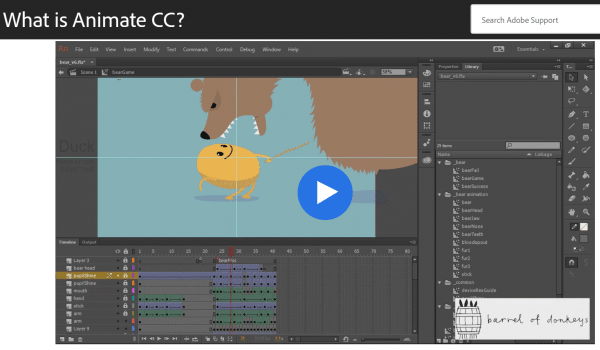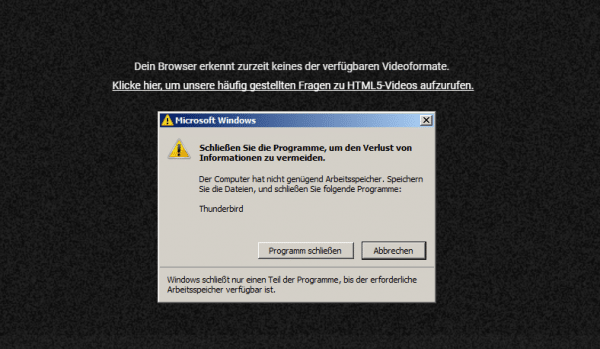Adobe Flash and HTML5 are the two great technologies for building animated, interactive websites or entire games for the browser. Which system is better is not that easy to answer. There are still a lot of Flash fans - but also Flash haters. And it's no different with HTML5.
Note: In July 2017, Adobe announced the end of Flash. As of 2020, Adobe does not want to publish any more updates for Flash..
Proprietary vs. open standard
The first big difference lies in its origin: Flash is a proprietary product from Adobe, HTML5 is an open standard. In practical terms, this means that Adobe has the sole say over the Flash Player, while with HTML5 standardization committees decide and the implementation then lies with the browser manufacturers, for example.
Dependence on a single company always tends to involve risks. If Adobe decides to crush Flash tomorrow, Flash is over. A standard, on the other hand, is much more transparent and can be entered and adapted from different sides. In theory, there is therefore a clear point here for HTML5. But unfortunately, unfortunately this also has disadvantages in practice.
Portability, performance, development
In the following section we compare Flash and HTML5 in terms of portability , performance and mobility , as well as development ..
Portability
And this disadvantage is that HTML5 applications do not (have to) look the same everywhere. There is only one Flash Player and consequently every Flash project looks identical on every device - just as a designer hopes. With HTML5, however, the display depends on the browser used and, if applicable, the operating system. If an application is nevertheless to look the same everywhere, this increases the development effort and is still not as reliable as Flash.
And Adobe has one more point regarding portability: Ultimately, Flash apps are just a single SWF file that can be easily stored and distributed. With HTML5 it's a whole hodgepodge of files and directories. This is not really relevant for every application, but if you just want to share your product, a Flash animation is even more convenient.
Performance and mobility
For the users of the applications, the question of performance is certainly much more interesting. Here you have to make a distinction between desktop and mobile: Desktops are usually so fast today that it doesn't matter whether a game was programmed with this or that technology. Both Adobe's hardware acceleration via Stage3D and its HTML5 counterpart WebGL offer more than enough power. On the smartphone or tablet, however, it looks very different..
 Youtube, here in the Chrome browser on Android, relies on HTML5 - a strong argument.
Youtube, here in the Chrome browser on Android, relies on HTML5 - a strong argument.
HTML5 offers more performance on mobile devices and can therefore be the choice of the hour, since smartphones and the like are at least as important as stationary desktops for most current applications. But two other aspects are much more important: On the one hand, HTML5 consumes less power. This cannot be put into a single number, but a realistic difference of 10 percent is not to be despised. On the other hand, HTML5 is available everywhere, every tablet can handle it. Flash, on the other hand, is not: The Flash Player for Android is still available directly from Adobe, but no longer on Google Play. And there is no official support for iOS at all.
When it comes to mobile device support, HTML5 has the edge. Even Adobe knows this and is not developing the Flash Player plug-in for mobile browsers any further.
Development
As a Pro for Adobe Flash, thousands of articles on the net list the better tool support, i.e. the available authoring tools. Most of the articles are now a few years old. The last major HTML5 turning point was the switch from YouTube to HTML5 in 2015. And there was definitely something to it at the time. As a relatively new technology, HTML5 could of course not fall back on the arsenal of a veteran like Flash. And there are really a lot of good authoring tools of all stripes out there for Flash.
On the other hand, the successor to the Adobe Flash Pro reference tool, Adobe Animate, can now use not only Flash, but also HTML5 as the output format. And that is a big step in the right direction. But Flash is still slightly ahead here, the developer community is too big, the documentation on the Internet too good and tools, templates and so on are too widespread. But that will turn around, guaranteed.
 Adobe Animate removes the separation between HTML5 and Flash authoring - it's just a question of exporting.
Adobe Animate removes the separation between HTML5 and Flash authoring - it's just a question of exporting. Past vs. future
If you want to sum it up very succinctly, you could say that Flash is a bit more comfortable today, if it works. And it is a mature, long-established technology - with massive security problems. HTML5, on the other hand, is more powerful and, above all, much more mobile. But it is still a young technology that is unfortunately not necessarily displayed in the same way in every browser.
In other words: Both currently exist in parallel, both have their right to exist, both their fans and areas of application. In the future, however, at some point HTML5 will be the only relevant standard for standard content, i.e. smaller games, video platforms and so on. Flash in its current form will soon be a thing of the past - but it may find a new existence as the technology of choice for increasingly complex games.
 You know it - Flash problems are unfortunately omnipresent.
You know it - Flash problems are unfortunately omnipresent.